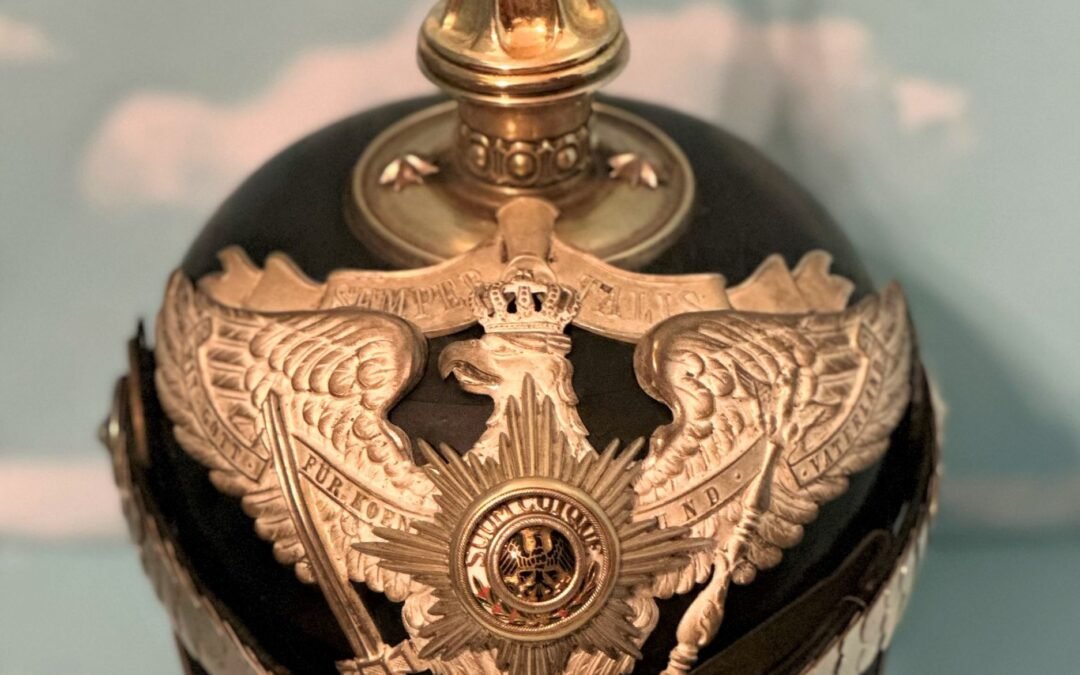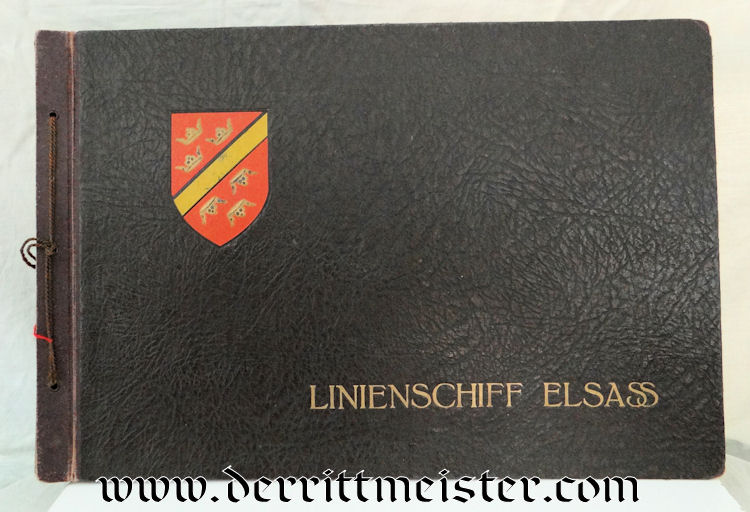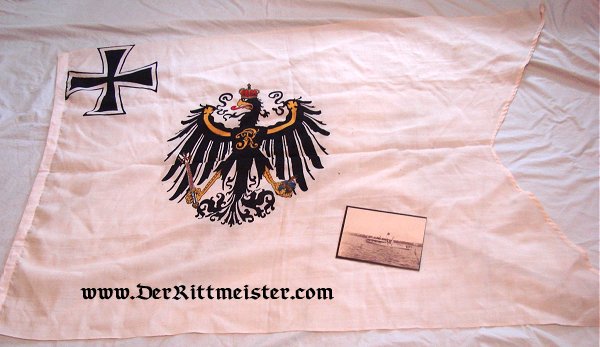
IMPERIAL GERMANY – GOBLET – KAISERLICHE MARINE / IMPERIAL GERMAN NAVY
This is an incredibly beautiful crystal wine goblet for a German Naval vessel. …

This is an incredibly beautiful crystal wine goblet for a German Naval vessel. …

This is an assortment of six patriotic stamps for:…..

The 1. Garde-Regiment zu Fuß was the most elite infantry regiment in the Prussian and German army. They along with the Regiment des Garde du Corps were the pride of Kaiser Wilhelm II. We offer a first rate officer pickelhaube for the 1. Garde-Regiment zu Fuß. Any spike helmet for this regiment is a prize, but one with the Semper Talis bandeau is a step ahead as we will discuss a bit later……

POSTCARD – KAISER WILHELM II AND ADMIRAL GEORG ALEXANDER VON MÜLLER
This is a WW I era postcard that was part of a very popular postcard series known as “Kriegskarten.” Its subjects are Kaiser Wilhelm II (1859-1941) and Admiral Georg Alexander von Müller (1854-1940). Von Müller first joined the Imperial German Navy in 1871 during Kaiser Wilhelm I’s (1787-1888) reign, when the Prussian/German Navy was little more than a coastal navy. He rose in rank, becoming Alfred von Tirpitz’s protegee. He held several ship commands, including the Battleship S.M.S. Wettin. He also served as adjutant to both Kaiser Wilhelm II and to his brother, Prinz Heinrich. He was appointed to the head the “Marine-Kabinett” (Navy Cabinet) in 1906, retaining the position until he retired in 1918.
The postcard shows the Kaiser wearing a General’s uniform and pickelhaube. He holds the Interim Generalfeldmarschall’s Baton in one hand, while the other hand rests on a sword. Von Müller wears a Naval Admiral’s Frock Coat, a Summer Officer’s Schirmmütze, and a sword. He sports a Breast Star and a Medal Bar on his coat. The two men are having a friendly discussion.

PICKELHAUBE – PRUSSIA – OFFICER – 1. GARDE-REGIMENT ZU FUß P – SEMPER TALIS BANDEAU.
This is a simply marvelous officer’s spiked helmet. The regiment was the most elite among Prussia’s and Germany’s Infanterie Regiments. It was garrisoned in Potsdam with its Kavallerie Regiment counterpart, the Regiment der Gardes du Corps. The 1. Garde Regiment zu Fuß was loaded with denizens from Imperial Germany’s highest royal and noble families. Every Hohenzollern Prinz was invested in it, including all of Kaiser Wilhelm II’s sons, just as the Kaiser himself had been as a young man. The Kaiser also served as its Regimental Chef (royal patron). The latter was a ceremonial post, since every regiment that possessed a royal patron actually was run on a daily basis by its true commander, typically an Oberst or Oberstleutnant. [Please remember that the 1. Garde Regiment zu Fuß also was notable as one of only two Prussian Infanterie Regiments to retain the Mitre as its headdress for high dress occasions. The Mitre had been the Infanterie’s preferred headdress prior to the pickelhaube’s introduction in 1842. After that date, all the other regiments switched to a combination of pickelhauben, schirmmützen and mützen for their headgear].
This magnificent helmet’s body is quite pleasing. Its leather is generally supple, with no major flaws to its surface. It is clean and in excellent condition for being more than one-hundred-years-old. Its silver body furniture is correct for the 1. Garde Regiment zu Fuß, including the wappen, chin scales, the base with pearl ring, helmet trim and spike. The fluted spike differs greatly from most pickelhauben’s spikes, lending it a very elegant look. The correct State and Reich’s kokarden are also present.
The wappen, however, is the true star here and deserves special attention. First, we can easily tell that the helmet is correct for the 1. Garde Regiment zu Fuß. [PLEASE NOTE: all the Regiment’s Bataillon Nr 1 and Regimental Staff Officers sported the “Semper Talis” bandeaux above the eagle on their wappens, as does this helmet]. The wappen boasts a fine, heavy patina. Such a patina adds an extra level of beauty to an item. Its massive eagle displays wings that extend PAST its kokarden. When you first look at the helmet, it seems as though these wings go on forever. The center of the eagle’s chest displays the Garde Star that decorates all Garde Regiment headdresses. The Garde Star exhibits a rich layering of red, white, black, and gold enamel. Its center displays a multicolored Black Eagle.
The Order of the Black Eagle is the House of Hohenzollern’s highest order. Certain levels of this Order were invested to all its House’s young princes. [Also, at the discretion of the King or (later) Kaiser, others NOT born to the House of Hohenzollern could be awarded this special honor. It was more of a royal honor than a direct military award]. As not only Prussia’s, but Imperial Germany’s most elite Infanterie Regiment, the 1. Garde Regiment zu Fuß was packed from top to bottom with royals and nobles from all over Germany. Aside from those on active duty, more than twenty-eight royals were assigned to it as à la Suite officers. Every House of Hohenzollern male was invested in it as a Leutnant at a young age. As they all grew older, they were promoted to higher ranks (depending on their individual situations). For example, in addition to being a Kaiserliche Marine Großadmiral Kaiser Wilhelm II’s younger brother, Prinz Heinrich, was a Generaloberst in the Rank of Generalfeldmarschall in the 1. Garde Regiment zu Fuß.
The helmet’s interior features a nearly-mint, dark-brown, leather sweatband. The smooth (NOT ribbed) silk liner attached to the leather sweatband is also dark-brown. [I see far fewer of these liners, which I personally find more elegant]. It is in mint condition. ALL of the hardware is 100% original to the helmet underneath that silk liner, extending to where the base, pearl ring, and spike are connected at the interior’s top. The same applies to the wappen’s securing hardware, which is original. Of course, NO double holes are present where it is secured.
This simply superb helmet in TOP condition is a consignment item. It also is value-priced. You will be hard pressed to find a better value on this particular type of helmet.

This amazing pickelhaube ensemble is a consignment item. It comes to us from two very special collections. It originally hailed from one of Europe’s premiere collections, and now has been consigned to DRM by the USA’s leading (in my opinion) pickelhauben collector. The helmet has become surplus to the gentleman’s needs, so he has entrusted us to find it a new home!…..

FRAMED PHOTO – S.M.S. VINETA – LIFE PRESERVER SHAPED. The S.M.S. Vineta was considered a Große Kreuzer (Heavy Cruiser), the forerunner of the Hochseeflotte’s battle cruisers. The ship was commissioned in 1899 as one of the Viktoria Luise Class’s five ships. [Viktoria Luise was Kaiser Wilhelm II’s only daughter, who married Braunschweig’s Herzog Ernst August]. The ship saw service in the West Indies, South America, Africa and even made port in the USA at New Orleans, Louisiana, and Newport News, Virginia. She also occasionally accompanied the Kaiser as an honor vessel when he summered in Norway aboard his royal yacht, the S.M.S. Hohenzollern.
All of the Viktoria Luise Class’s five ships underwent modernization between 1905 to 1910. Part of the latter process was converting from three funnels to two. Our photo shows the ship with its original three funnels, indicating that it dates prior to 1905.
When WW I began, the Vineta was assigned to coastal defense in the Baltic under Großadmiral Prinz Heinrich’s command (he was Kaiser Wilhelm II’s younger brother). She did not serve in this role for long, then was anchored at Kiel to serve as a floating barracks for U-Boot crews while they were in port. She was scrapped in 1920.
Today we are offering a photograph of the S.M.S. Vineta that is framed within a life preserver replica. These frames were quite popular among sailors and their families. The frame measures 4 ¾” in diameter, while the photo within measures 3 ½” in diameter. The wooden frame is red, with “S.M.S.” painted in white at the top. The ship’s name, “Vineta,” appears at the frame’s bottom. Glass protects the photograph. Four thin fabric bands appear around the frame. A thin rope is threaded around the frame, which could serve as a hanger at the frame’s top. It could be hung on a wall or just displayed as a decorative piece.

This is an interesting multicolored metal wall plaque depicting the Heavy Cruiser Kaiserin Augusta’s goodwill visit to New York City. The Augusta was accompanied by the three-masted windjammer Seeadler to participate in a belated celebration of the 400th anniversary of Columbus’s first voyage across the Atlantic.
The plaque measures 8″ x 12″ and features four corner holes by which it can be attached to a flat surface. The plaque itself is slightly vaulted in its center. Several ships, a buoy and the ocean waves are rendered in high-relief. The picture is actually a reproduction of an 1895 chromolithograph by Carl Saltzmann (1847–1923) of the event. [Saltzmann was a Berlin-born marine and landscape painter who completed several paintings of Kaiser Wilhelm II and his brother, Prinz Heinrich, on board their ships]. It depicts the white Kaiserin Augusta steaming out of New York Harbor. The kriegsflagge is visible at her stern. Another kriegsflagge and the Kaiserstandarte appear in the plaque’s upper right corner. A number of vessels, including a paddlewheel steamer, appear on her starboard side, including what looks like the Seeadler’s silhouette further in the background. The Statue of Liberty resplendently brandishes her torch to the Augusta’s stern, also on the ship’s starboard side. A large buoy bobs in the water at the ship’s port side. The caption “Kaiserin Augusta verläßt Neuyork” (Kaiserin Augusta leaves New York) appears at the plaque’s top.
I want to stress that this is a modern-day reproduction of the period painting, not a period piece. I picked it up on a recent trip to Germany. It is colorful and well made, and beautifully presents a marine painting from the Imperial German era.

Alfred von Tirpitz (1849-1930) was one of the Kaiserliche Marine’s best known admiräle (admirals). The shoulder board measures 1 7/8″ x 4 3/16.” It displays four gilt-toned pips on its obverse. Its reverse reveals that it is of the slip-on variety, which is correct. Its backing material boasts a rich, 100% correct, navy-blue color that is proper for a naval officer’s shoulder boards. We can also see where each pip has been attached.
In addition we are offering a postcard and handwritten letter…..

This is an interesting postcard or original photograph album from the Battleship S.M.S. Elass. The S. M. S. Elass was a part of the five-ship Braunschweig Battleship Class (Linienschiffe). She was commissioned in 1904. By the time WW I began, she was considered obsolete. She was assigned to the Baltic fleet under Prinz Heinrich’s command. The S.M.S. Elass participated in a couple of minor engagements with Russian ships, was used for coastal defense, and finally was anchored at Kiel, where she was used as a floating barracks. She was scrapped in 1936.
The album has a pebbled exterior and measures 16 ½” x 11″ x 1 1/4,” Embossed on the front cover is a shield with the S.M.S. Elass’s Coat-of-Arms. [Elass is the German word for Alsace, part of the Alsace-Lorraine territory along the French and German borders, with both French and German-speaking citizens. It was seized by Germany during the 1870-1871 Franco-Prussian War, and returned to France in 1919 as a result of the Treaty of Versailles]. Along with its Coat-of-Arms, the album is imprinted in gold with “Linienschiff Elass.”
The album is massive, with a total of thirty-five double pages. Each page has the capability of housing eight postcards or postcard-sized photographs. The album can accommodate a total of two hundred-eighty (280) photographs/postcards. Each page is shielded by a protective glassine sheet. The inside back cover sports a tag for the Wilhelmshaven shop where it was purchased.
The album is in excellent condition, overall. It is a unique artifact from the Kaiserliche Marine. It is a marvelous album for housing any postcard or photograph collection, especially a Navy one.
This is a most interesting photographic collage of a sailor who served aboard the S. M. S. Kaiserin. The Kaiserin was a part of the four-ship “Kaiser” Battleship Class. She was commissioned in 1913 and participated in many naval actions during WW I. Most important, she participated in the Battle of Jutland, which took place on 31 May 1916.
The collage’s center shows a sailor in his dress tunic. It is quite clear that he belonged to the S. M. S. Kaiserin’s crew. Surrounding the ship are other bits and pieces that include Kaiser Wilhelm II and his younger brother, Prinz Heinrich. Both men are in an admiral’s gala (dress) uniform. Below the sailor we see a line of battleships at speed.
The collage’s frame is a real attention-getter. It measures 4 1/4″ x 6 ½.” It sports a classy shade of brown, and its four, beautiful, rounded corners simply take one’s eyes hostage! The frame’s interior measurements are 3 7/8″ x 5 5/8.” Its reverse has two places from which it could be hung from a wall. It also has an easel that allows the frame to be set up on a flat surface. You will truly enjoy this one!

Hallmarked, Jeweler’s (Wearer’s) copy of the Orden Pour le Mérite with the very rare Oak Leaves dated from the 1914-1929 period……

The pageantry afforded to House of Hohenzollern members was on par with other royal European houses. As with England, the naval tradition was very important to Wilhelm II. He spent lavishly on his fleet in an effort to match the British Royal Navy. Kaiser Wilhelm II was a Großadmiral in the Kaiserliche Marine, as was his brother, Prinz Heinrich. Both men had a son who served in the Navy (Prinz Adalbert and Prinz Sigismund, respectively). Traditionally, when a prinz was aboard a vessel, the ship raised a special flag signifying his presence. We currently are offering a large banner that was flown aboard battleships when a prinz was aboard. Today we are offering something even more unusual. It is a pairing of a photograph, and a flag that was flown from a small pleasure craft on the Wannsee in Berlin. The photograph comes from a photographic studio in Berlin. It measures 6″ x 7 3/4.” It depicts a small pleasure craft, which I estimate to be 45′ to 55′ in length. Flying from its stern is the very flag we are offering today! It measures 59 1/2″ x 39.” In its center is a Hohenzollern Eagle. An Iron Cross is in the corner. The flag is swallow-tailed. It is made of a light-cotton material that is gauzy in appearance. Some light mothing shows in a few places, but the flag remains in very good condition.

Beginning in the late 19th Century, Germany began building up its presence in China…..